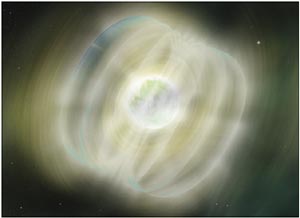An extremely bright and long afterglow of a rather common gamma-ray burst (GRB) was observed during four months by the X-ray telescope of NASA’s Swift satellite. Such a long-lasting X-ray emission challenges theoreticians who now suggest that some bursts are powered by a neutron star rather than by a black hole.

Image credit: Aurore Simonnet SSU NASA E/PO.
With the detection of about 100 GRBs each year, NASA’s Swift spacecraft – launched in November 2004 – is by far the most efficient hunter of these brief gamma-ray flashes. The strength of Swift is its ability to repoint its X-ray and ultraviolet/optical telescopes to the location of the burst within two minutes. This allows it to study in detail the early phases of the GRB afterglow emission (CERN Courier December 2005 p20). From all of these observations, researchers derived a general pattern of the X-ray brightness evolution. The X-ray emission usually starts with a rapid decay extending that of the GRB itself. After a few minutes, the X-ray decay rate slows down and remains moderate for at most a few hours before accelerating again for a final decay at an intermediate rate. After several weeks the source becomes generally undetectable for Swift. In some cases, additional bright X-ray flares have been observed during the first 15–20 minutes after the burst (CERN Courier October 2005 p11).
Not all GRBs follow this general trend. Two recent studies describe unusual afterglow emissions. Dirk Grupe from the Pennsylvania State University is leading an analysis of the GRB of 29 July 2006 (GRB 060729). At a redshift of z = 0.54, this not too remote burst was exceptionally bright in X-rays and, thanks to its slow fading, Swift’s X-ray telescope detected it during 125 days: a record for Swift only bettered by the closer “Rosetta stone” GRB of 29 March 2003 (CERN Courier September 2003 p15). A phase of very slow X-ray decrease, starting about 10 minutes after the burst and lasting almost half a day, characterized the lightcurve of GRB 060729. This requires continuous energy injection from the central engine over this long period. One possibility is that the collapsed core of the dying star at the origin of the GRB is a magnetar rather than a black hole. The ultra-powerful magnetic field of such a neutron star would force it to spin-down rapidly and the associated energy would be continuously injected into the X-ray emitting blast wave.
The study of another burst that Swift detected on 10 January 2007 also suggests that magnetars power some GRBs. GRB 070110’s afterglow is slightly shorter in duration, but its time evolution shows a plateau of almost constant X-ray flux lasting 5 hours followed by an extremely fast decay before returning to a more typical late afterglow behaviour. This unusual plateau state is again interpreted as being due to a magnetar by an international team led by Eleonora Troja working at the Palermo division of the Italian National Institute for Astrophysics (INAF).
These results shake the general belief that GRBs are always powered by a black hole and less energetic X-ray flashes could be explained by the presence of a magnetar instead of a black hole (CERN Courier October 2006 p13). It seems that GRBs are willing to keep some of their mystery and will continue to challenge theoreticians for several years.
Further reading
D Grupe et al. 2007 Astroph. Journal, in press. See http://arxiv.org/abs/astro-ph/0611240.
E Troja et al. 2007 Astroph. Journal, submitted for publication. See http://arxiv.org/abs/astro-ph/0702220.








